Skrämmer tanken på att resa med SIBO dig? Är du orolig att du aldrig kommer att kunna lämna hemmet igen?
Den goda nyheten är att att ha SIBO betyder inte att du behöver vara en eremit. Jag är en ivrig resenär som har besökt många länder sedan min SIBO-diagnos. Och jag är här för att berätta att det ÄR möjligt att resa med SIBO.
Den senaste månaden har jag rest till och från USA två gånger. Det är 4 långdistansflyg plus kortare inrikesflyg. Jag har samlat mina och The Healthy Gut-communityts bästa tips om hur du flyger internationellt med SIBO åt dig.
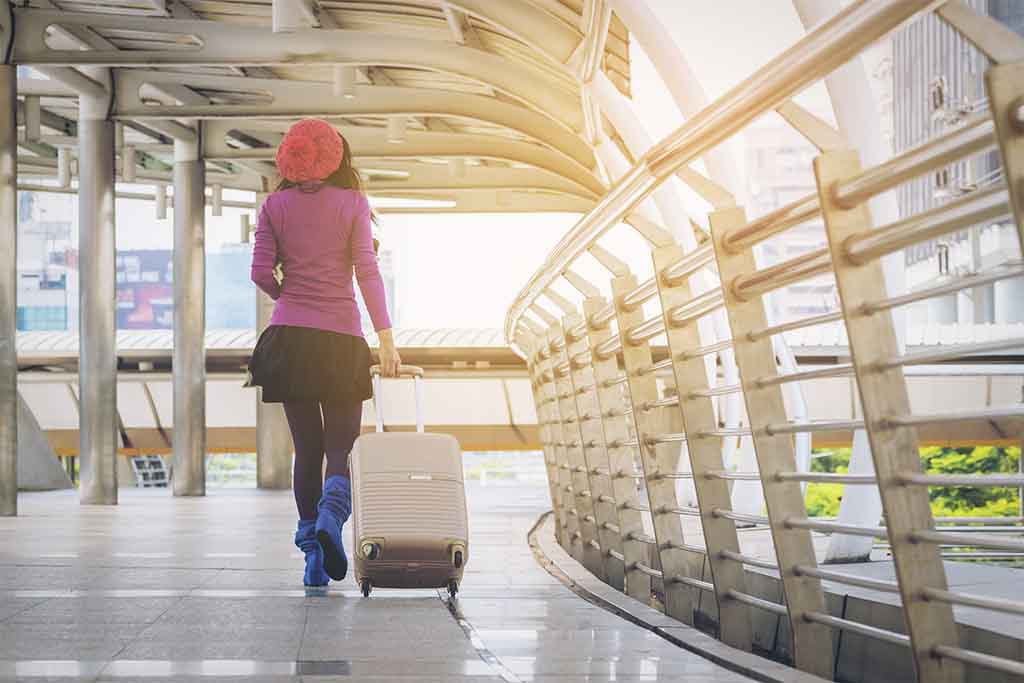
Om du ska investera i en internationell resa, snåla inte med flyget. Erfarenheterna du har med ett flygbolag kan göra starten och slutet av din resa fantastisk eller hemsk. Du vill njuta av ditt flyg, och flygbolaget du väljer kan spela en stor roll för att göra det möjligt.
Tänk på vad som är viktigt för dig:

Hastigheten som du kan nå din destination



































Antalet anslutningar du behöver göra eller ett direktflyg utan mellanlandning



































Bekvämligheter ombord



































Måltidsalternativ



































Sittlutning och bredd



































Uppgraderingsalternativ
När jag reser längre än några timmar sätter jag alltid min komfort som högsta prioritet. Jag väljer flygbolag som tillåter uppgraderingar till en mer premiumkabin och erbjuder en bra service ombord. Jag flyger Virgin Australia till och från USA eftersom du kan lägga ett bud på Premium Economy och Business stugorna. Jag köper en Economy-stol och bjuder sedan lägsta möjliga summa för en uppgradering. Om jag inte får det har jag inte betalat något, så det är ett bra alternativ. Jag har bara missat en uppgradering en gång och har haft turen att bli uppgraderad till Business på flera resor.
Jag har också flugit Air New Zealand till USA på flera resor, och deras Premium Economy och Business stugor är fantastiska, plus att deras service är enastående, även om de inte erbjuder budalternativet som Virgin Australia gör, men har ofta bra försäljning så att du kan hämta ett pris för ett bra pris.
Självklart, om du har råd att köpa en premiumstol, gör det! Det gör flygningen så mycket roligare.
Jag har flugit billigare flygbolag internationellt tidigare, men har kommit utmattad efter att ha varit proppad som en sardin i timmar, och till och med utsatts för sexuella övergrepp på en flygning med Royal Brunei Airlines (London till Melbourne), där personalen och flygbolaget inte gjorde något åt det . Jag hade köpt det flyget för att det var så billigt; det verkade för bra för att vara sant. Det var och jag kommer aldrig att gå för det billigaste flygbolaget igen.
"Resor är en underbar upplevelse. Låt inte SIBO hindra dig från att göra saker du älskar."
Rebecca Coomes
Jag flyger alltid med flygbolag på långdistansflyg som gör att jag kan välja min plats i förväg. När du har SIBO har du tillräckligt med ångest för att komma på toaletten. Du behöver ingen extra ångest över att inte ha en bekväm sittplats.
På långdistansflyg är jag alltid välj en gångsits så att jag lätt kan ta mig upp på toaletten och inte behöver klättra över främlingar eller störa någon av mina ständiga toalettbesök.
Om du tar ett nattflyg kanske du gillar en fönstersits så att du kan vila mot planet medan du sover. Själv blir jag för orolig vid tanken på att inte kunna gå på toaletten, så jag kommer alltid att föredra en gångsits framför en fönstersits.
Vill du se vilka de bästa platserna är på ditt flyg? Kolla in Seat Guru där du kan ange ditt flygbolag och flygnummer, så kommer de att visa dig vilka de bästa och sämsta platserna är på planet.
Precis som ditt val av stolar är viktigt för att minska din toalettångest på flyget, är det också viktigt att välja att flyga med ett flygbolag som erbjuder ett brett utbud av måltider ombord.
Scrolla ner för att se mina tankar om att äta på ett flygplan, men jag tror att det är viktigt att ha en måltid tillgänglig för dig, även om du inte äter den.
När du flyger Economy får du en standard måltid (inga flashiga menyer här) och kommer i allmänhet att ges 2-3 alternativ. Du kan dock skicka in en särskild måltidsbegäran i förväg. De flesta flygbolag kräver 48 timmars varsel, men kolla med ditt flygbolag så att du inte missar att få en lämplig måltid.
Välj den typ av mat som är mest besvärande för dig. För mig är det gluten. Även om det för närvarande inte finns ett Low FODMAP-måltidsalternativ tillgängligt hos flygbolag, kan du välja från en rad olika måltider, inklusive:



































Glutenfri



































Lactose free



































Bland meal (no onion, garlic, spices, strong seasonings)



































Vegetarian and vegan
Sadly, you can't combine 2 or 3 meal types. For instance, you can't request a meal that's gluten and lactose-free and bland, which is what most SIBOers will need.
When flying in Premium Economy, Business or First, you will be presented with a lot more meal options. I have found that I can pick regular meals off the menu, rather than having to pre-order a special meal, because there's always a gluten free option.
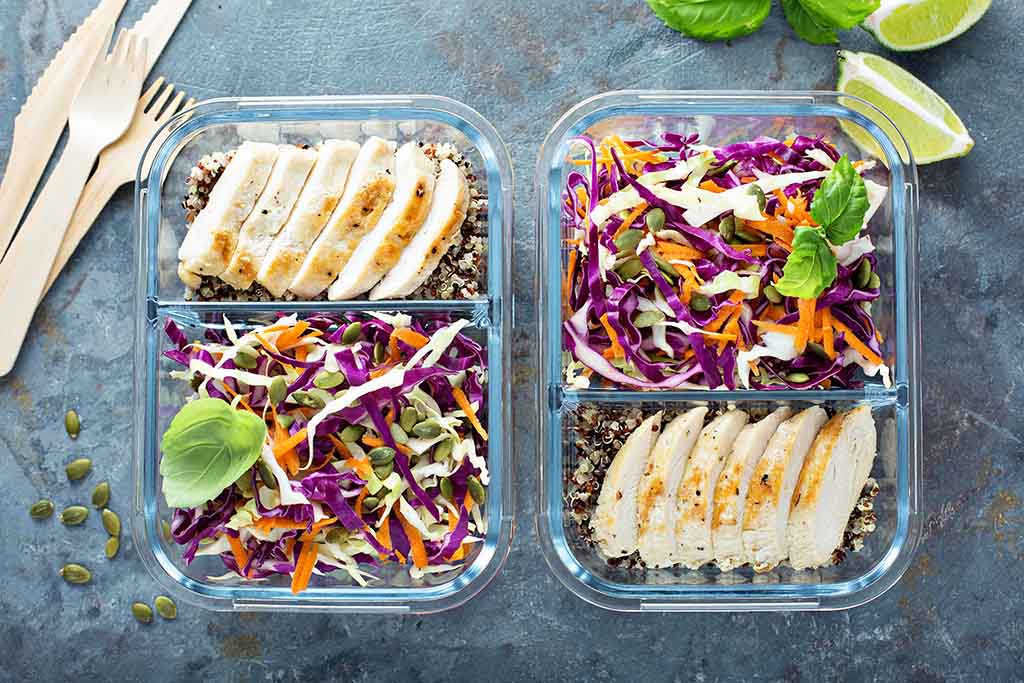

There are fluid restrictions on long-haul flights (maximum of 100ml per container) but there aren't currently food restrictions. However, it's always advisable to contact your airline to double check if you have any doubts.
If you want to eat on your flight, you might prefer to bring your own food and snacks for the flight. You can purchase an insulated bag with ice pack inserts (like this one ). Some great meal and snack options include:



































Grilled chicken pieces



































Slices of cooked beef or lamb



































Tins of tuna or sardines (your neighbours might not love you for this though)



































Salad or cooked vegetables



































100ml container of salad dressing



































Veggie sticks with a small container of chunky roasted pumpkin and macadamia dip



































Pieces of fruit



































Nuts and seeds



































Nut butters in individual portions



































Jerky



































Individual portions of cheese (if tolerated)



































SIBO friendly crackers



































Potato or vegetable chips cooked in suitable oil and seasoned with salt



































A container of my Prosciutto, Egg and Capsicum Muffins or Blueberry Muffins



































Chocolate bark , flavoured chocolates or choc chip granola bars for a sweet treat



































The Elemental Diet - I use the Integrative Therapeutics Physicians Formula (bring the powder and a shaker. You can ask for ice and water to make it into a drink)
You won't be able to take your food into your arrival destination so don't go crazy - just bring as much as you think you can eat so you don't have to throw a lot of food out at the end of the flight.
In case the security screening confiscates your ice packs, always pack a leak-proof zip lock bag says Monica Hardy from our SIBO Bi Phasic Diet Facebook Group . She asks the flight attendants to fill it with ice once she gets on the plane so she can still keep her food cool.
You don't have to eat on a long-haul flight. Instead, you may choose to use the time to fast and just sip water or herbal teas.
Personally, I find having an empty stomach easier on my body than having it full of food. I always bloat on flights, no matter what I do, so the more I avoid food, the easier it is on my system.
I do find that I get very hungry on long-haul flights, so even if you decide to fast, I would recommend you have a back up in case you change your mind. When everyone else is brought their food and the cabin is full of food smells, it can be very difficult to maintain your resolve to keep fasting.
Because I always bloat on long-haul flights, I always wear loose fitting clothes with stretchy waistbands that will allow my belly to grow over the course of the flight. There is nothing worse than being stuck in tight-fitting clothes, in pain from the bloating, and not able to do anything about it.
I also like to layer my clothes. This helps hide the bloating. I take a long scarf, a long cardigan and a jacket. That way I can layer up if I get cold or strip down to a lighter top if the plane is hot. Most of the trips I've done recently are freezing cold, so I'm always glad I've got multiple layers.
I also spray my scarf with perfume or essential oils so that if there are smells on the plane that I don't like, I can bury my nose in my scarf and avoid them.
Finally, pack a spare pair of underwear and clothes. I always plan for the unexpected. If you have an upset tummy and have an accident, you can feel better knowing you can change your clothes. Or, if your luggage goes missing, you at least have one outfit and new underwear to wear.
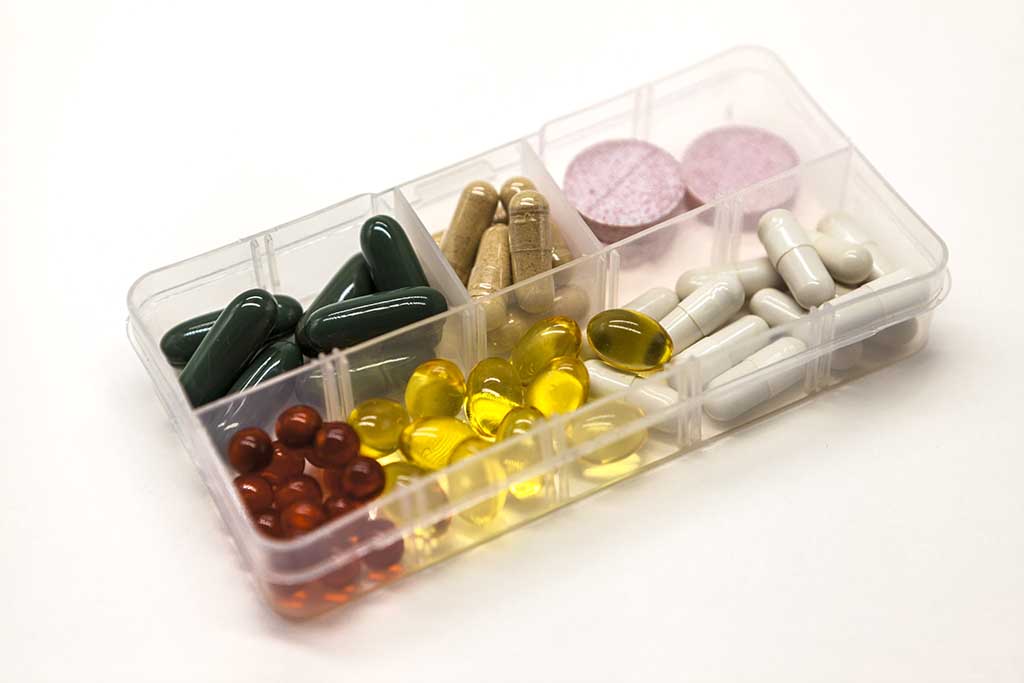

Talk to your Practitioner about your forthcoming trip. They will review your medication and may even suggest some additional supplements to support you. Before I flew to Thailand, I saw my Naturopath and we added in some extra herbs to help prevent potential food poisoning.
Choose where you will carry your medication. I put it in my hand luggage. That way, if my main bag is delayed, I still have my medication with me. Get a small cooler bag for any medication that needs to be kept refrigerated.
Ensure you have enough for the duration of your trip. You don't want to run out in a foreign country, where you might find it hard to get replacements.
During the flight, you may want to take some supplements to help with any symptom you experience. Dr Allison Siebecker has a handout with a range of supplements for each type of symptom . Some common supplements to pack include:



































Activated charcoal



































Iberogast



































Gas X



































Peppermint oil



































Magnesium



































IBGuard



































Electrolyte replacement or oral rehydration



































Imodium
Changing time zones? Get ready for your new time by getting to bed earlier or staying up later in the days leading up to the flight and before you head home. Timeshifter is a handy app that helps you prepare for your new timezone by giving you tips on when to avoid or get things like sunlight, caffeine, sleep and melatonin.
Most international flights come with in-flight entertainment. However, I have been on a handful of flights where the entertainment system has broken. For this reason, I always have a backup plan. I download Netflix movies and tv shows onto my iPad, which I can watch when I'm offline. I have a couple of books available in my Kindle app on my iPhone and have enough podcasts and audiobooks downloaded that I can listen to them for the full duration of the flight if I need to.
If you're an anxious flyer, why not download a meditation app to your phone, so you can do some meditation while you're flying?
Aeroplanes are notoriously germ-ridden places. Everything from faecal matter to Methicillin-resistant Staphylococcus aureus (MRSA) bacteria has been found hiding in the passenger cabin of planes.
Pack anti-bacterial wipes in your carry-on bag and use them to clean your armrest, tray, seat belt clip, toilet door handle and flush.
I also use the Biocidin Throat Spray during the flight. It helps ward off any germs that are spread if people are coughing and spluttering on the plane.
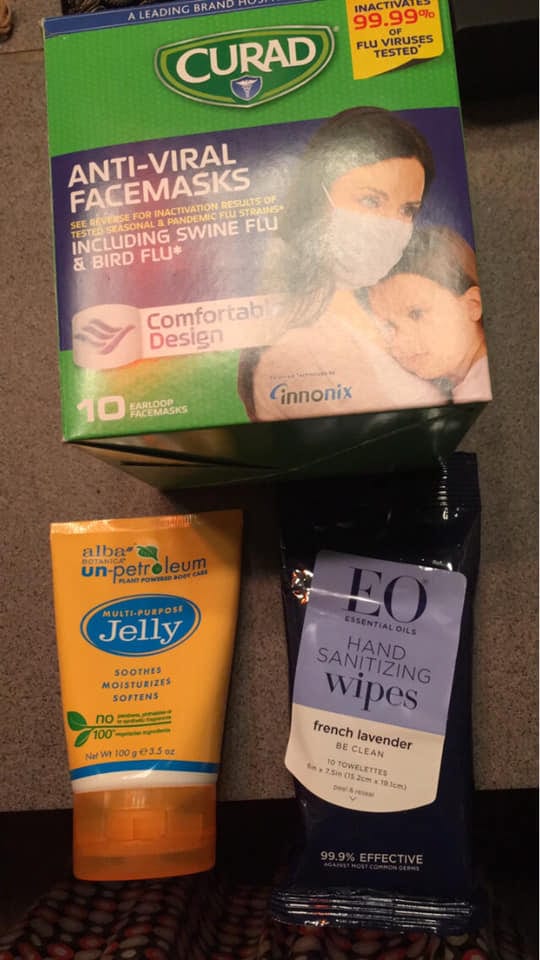

My SIBO Coaching client , Sharon Treadgold packed these items for her recent trip to Australia from the US. The face masks gave her an added sense of security that she wasn't breathing in other peoples' germs.
Oavsett om du planerar att vara vaken eller sova på flyget kan det hjälpa dig att känna dig mer avslappnad om du tar med dig några hembekvämligheter. I travel with noise cancelling headphones, my own blanket, a revitalising moisturiser from Ecology Skincare , a neck pillow, eye mask and ear plugs. I also wear flight socks and have a pair of flip flops handy so I can walk into the toilet with shoes on.
Studier har visat att filtarna du får på planet inte är alltför hygieniska, eftersom de inte rengörs regelbundet, trots att de kommer i ny plastfolie. Du kan bara föreställa dig saker som folk använder dem till:att torka smutsiga händer, blåsa näsor, byta blöjor på eller andra lika obehagliga aktiviteter. It’s not something we want to snuggle up with.
Aeroplane travel is extremely dehydrating. The longer you spend on a plane, the more dehydrated you will become. It is important you are constantly sipping water to keep your body hydrated. Avoid alcohol as this increased the dehydration and can also cause digestive distress.
I take an empty water container through security and then fill it up before I board the flight. I then ask the staff to fill it up with water during the flight.
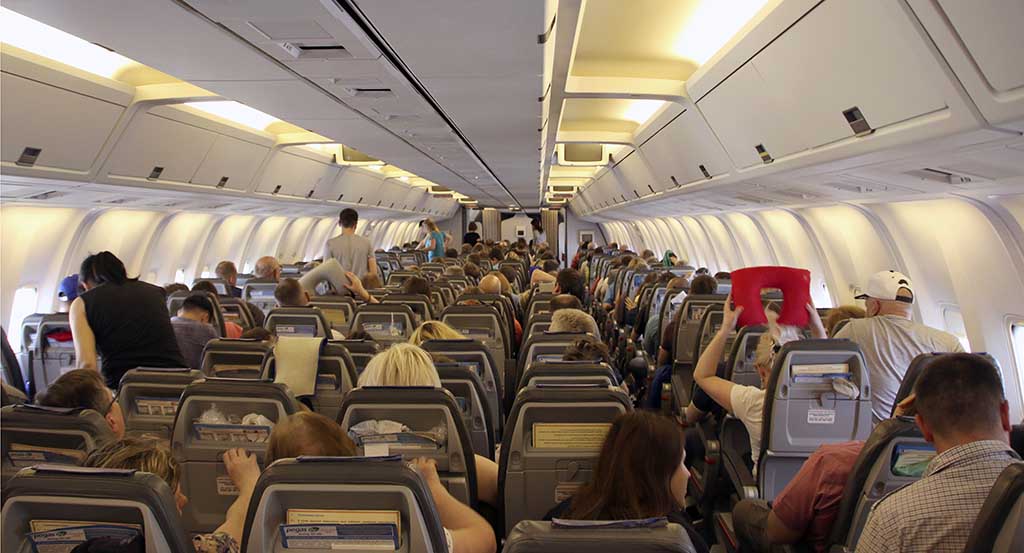

When you are sitting down for many hours at a time, your digestion can slow down and get sluggish. Whenever possible, get up and move your body on the flight. I like to walk up and down the aisles or I will go and stand down the back of the plane and do some simple stretches. If you have a layover, use it as an opportunity to stretch your legs. I walk up and down the terminal, moving constantly until I need to get back on the plane.
On my most recent flight to the US, I departed Melbourne at 11.30am. As soon as I got on the plane, I changed my watch to US Pacific Time and started telling myself that it was 6.30pm. As soon as we had been fed dinner, I told myself it was bedtime and took a melatonin tablet and went to sleep. When I arrived at LAX at 9am, I was relatively refreshed and ready for the day ahead.
The first thing I do when I arrive at my new destination is to go outdoors and get some fresh air and sunlight on my skin. This helps acclimate to my new timezone and environment. Even if I have arrived at a winter destination, I wrap up nice and warm and head out.
If the weather is warm, I like to touch the ground with bare feet. Dave Asprey of Bulletproof fame talks about how earthing helps return the body to a neutral current. I personally find it beneficial and make an effort to touch the ground with bare feet whenever I can.


After many hours crammed into a plane, there is nothing better than moving your body. It helps to get fresh oxygen to all parts of your body, and can also help reset your circadian rhythm to your new timezone. I always pack a sturdy pair of walking shoes and hit the pavement of my new location. It's a great way to check out your new neighbourhood while also exercising. Check out a local yoga or pilates class for some structured exercise or do a walking tour.
You might be off the plane, but it doesn't mean your body isn't still recovering from the impact of long-haul travel. Keeping your food simple will help ease the pressure on your gut. I love nothing more than some steamed or grilled fish and steamed veggies when I first arrive. Also keep your meal sizes small to give your gut a chance to process the food. As tempting as it might be, avoid alcohol as this will contribute to your dehydration and can interrupt your sleep cycle.
I always incorporate intermittent fasting into my travel routine. It helps my gut calm down from the pressure of travelling, and I find I sleep better when I haven't eaten a lot.
You might like to ensure you get at least 12 hours break between dinner and breakfast, or if you're like me, you can skip breakfast entirely and just eat lunch and dinner.


Spend the first few days of your new location focusing on hydration. Your body has been put under enormous pressure on the plane, so be kind to it and drink lots of good quality, filtered water.
Doing all of the above will help re-set your circadian rhythm. If you arrive in the morning, stay awake as long as you can, ideally going to bed at your normal bedtime.
If you must take a nap, keep it short so you don't confuse your body and further disrupt your sleep cycle.
If you are still struggling to sleep, you might like to take a sleeping aid. I use Integrative Therapeutics Cortisol Manager to help re-set my cortisol levels. If this isn't enough support, I will also take some melatonin at bedtime. This will normally put me to sleep within 30 minutes of taking it.
If you wake during the night, try to avoid turning on any electrical devices. The blue light emitted from these devices can disrupt your sleep-wake cycle. Instead, try some meditation, deep breathing or relaxation techniques. If that fails, I will lay in bed and read a book until I get sleepy again.
It is estimated that for every 1 hour of timezone change, it can take 1 day to recover. Be kind to yourself during this recalibration to your new time zone. If sleep isn't coming easily, stressing about it will make it worse. You will get into your new timezone eventually.


It is a privilege to travel and see new parts of the world. Yes, SIBO can be frustrating, but you have control over how you think . If you choose to approach travel with fear, it's highly likely your trip will be extremely stressful. Instead, if you approach your trip with interest and intrigue and allow for situations to happen that are outside of your control, you will enjoy your trip much more.
I love the uncertainty of travel. I love meeting new people, tasting new food, learning new languages, smelling new smells, seeing new cities and landscapes, and even when things go wrong, I find a way to laugh about it.
Before you go, brainstorm a wide range of possible scenarios and think about how you will handle those situations. The more prepared you are, the easier they will be to cope with.
Do you have your own fool-proof travel hacks? I would love to hear them. Simply put them in the comments below.
Pin945 Shares Så blir du av med gas omedelbart
Så blir du av med gas omedelbart
 Stillståndssjukdom (systemisk juvenil idiopatisk artrit)
Stillståndssjukdom (systemisk juvenil idiopatisk artrit)
 Välja sjukdom med så mycket kvar att ge
Välja sjukdom med så mycket kvar att ge
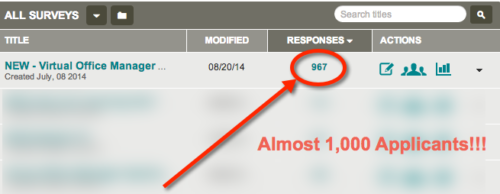 Så du brinner för kost (hur man gör det till en karriär)
Så du brinner för kost (hur man gör det till en karriär)
 Förändring av övre andningsmikrobiom hos barn relaterat till känslighet för SARS-CoV-2
Förändring av övre andningsmikrobiom hos barn relaterat till känslighet för SARS-CoV-2
 Varför Paleo FX återuppväckte mitt engagemang för hälsa
Varför Paleo FX återuppväckte mitt engagemang för hälsa
 Sellerijuice:Bra för magen eller 'Gotta Go'?
Att som dietist hålla koll på de senaste mat- och kosttrenderna kan kännas som ett helt jobb i sig. Det finns ständigt nya och alltmer bisarra dieter, rengöringar och detoxprogram som kommer ut på mar
Sellerijuice:Bra för magen eller 'Gotta Go'?
Att som dietist hålla koll på de senaste mat- och kosttrenderna kan kännas som ett helt jobb i sig. Det finns ständigt nya och alltmer bisarra dieter, rengöringar och detoxprogram som kommer ut på mar
 Är kapselendoskopi säker?
Vad är kapselendoskopi? Ett kapselendoskop rymmer en kamera och lyser i ett genomskinligt hölje. En patient sväljer kapseln och kameran tar förstorade bilder och video för diagnos av gastrointestin
Är kapselendoskopi säker?
Vad är kapselendoskopi? Ett kapselendoskop rymmer en kamera och lyser i ett genomskinligt hölje. En patient sväljer kapseln och kameran tar förstorade bilder och video för diagnos av gastrointestin
 Hur du förbättrar ditt tänkesätt så att du läker snabbare
När jag fick reda på att jag hade celiaki tänkte jag Bra! Jag behöver bara sluta äta gluten så blir jag helad!” Fel. Sedan upptäckte jag SCD och jag tänkte, Jag behöver bara följa den här dieten p
Hur du förbättrar ditt tänkesätt så att du läker snabbare
När jag fick reda på att jag hade celiaki tänkte jag Bra! Jag behöver bara sluta äta gluten så blir jag helad!” Fel. Sedan upptäckte jag SCD och jag tänkte, Jag behöver bara följa den här dieten p